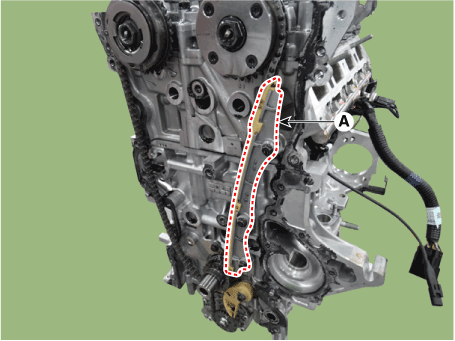Hyundai Elantra: Timing System / Timing Chain
Hyundai Elantra (CN7) 2021-2025 Service Manual / Engine Mechanical System / Timing System / Timing Chain
Components and components location
| Components |

| 1. Variable force solenoid valves 2. Timing chain cover 3. Cam to cam guide 4. Timing chain 5. Timing chain tensioner arm | 6. Timing chain tensioner 7. Crankshaft sprocket 8. Oil pump chain 9. Oil pump chain tensioner 10. Timing chain guide |
Repair procedures
| Removal |
| 1. | Disconnect the battery negative terminal. |
| 2. | Turn the crankshaft damper pulley clockwise, and align its groove with the timing mark of the timing chain cover.
|
| 3. | Remove the timing chain cover. (Refer to Timing System - "Timing Chain Cover") |
| 4. | Remove the cam to cam guide (A).
|
| 5. | Remove the timing chain tensioner (A).
|
| 6. | Remove the timing chain tensioner arm (A).
|
| 7. | Remove the timing chain (A).
|
| 8. | Remove the timing chain guide (A).
|
| 9. | Remove the oil pump chain. (Refer to Lubrication System - "Oil Pump") |
| 10. | Remove the crankshaft sprocket (A).
|
| Inspection |
Sprockets, Hydraulic Tensioner, Chain Guide, Chain Tensioner Arm
| 1. | Check the camshaft sprocket, crankshaft sprocket teeth for abnormal wear, cracks or damage. Replace if necessary. |
| 2. | Check a contact surface of the chain tensioner arm and guide for abnormal wear, cracks or damage. Replace if necessary. |
| 3. | Check the hydraulic tensioner for its piston stroke and ratchet operation. Replace if necessary. |
| Installation |
| 1. | Install the crankshaft sprocket (A).
|
| 2. | Place the crankshaft key at the left 180°.
|
| 3. | Install the oil pump chain. (Refer to Lubrication System - "Oil Pump") |
| 4. | Install the timing chain (A).
|
| 5. | Install the timing chain guide (A).
|
| 6. | Install the timing chain tensioner arm (A).
|
| 7. | Install the timing chain tensioner (A).
|
| 8. | Install the cam to cam guide (A).
|
| 9. | After rotating crankshaft 2 revolutions in regular direction (clockwise viewed from front), confirm that the TDC marks on the intake and exhaust CVVT sprockets are aligned with the top surface of cylinder head.
|
| 10. | Install the timing chain cover. (Refer to Timing System - "Timing Chain Cover") |
| 11. | Install the other parts in the reverse order of removal. |
 Timing Chain Cover
Timing Chain Cover
Repair procedures
Removal
•
Use fender covers to avoid damaging painted surfaces. •
To avoid damage, unplug the wiring connectors carefully while holding the connector portion...
Other information:
Hyundai Elantra (CN7) 2021-2025 Owner's Manual: Driver Attention Warning (DAW)
Basic function Driver Attention Warning can help determine the driver's attention level by analyzing driving pattern, driving time, etc. while vehicle is being driven. The system can recommend a break when the driver’s attention level falls below a certain level. Leading Vehicle Departure Alert function Leading Vehicle Departure Alert function can inform the driver when the front vehicl..
Hyundai Elantra (CN7) 2021-2025 Owner's Manual: ESC OFF usage
When Driving The ESC OFF mode should only be used briefly to help free the vehicle if stuck in snow by temporarily stopping operation of the ESC to maintain wheel torque. To turn ESC off while driving, press the ESC OFF button while driving on a flat road surface. NOTICE To prevent damage to the transmission: Do not allow wheel(s) of one axle to spin excessively while the ESC, ABS, and ..
Copyright © 2025 www.helantra7.com
















